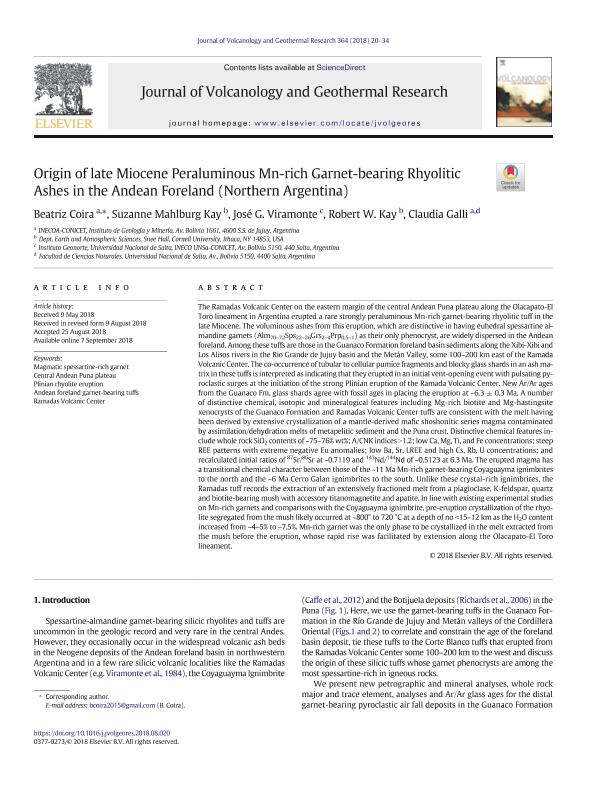Artículo
Origin of late Miocene Peraluminous Mn-rich Garnet-bearing Rhyolitic Ashes in the Andean Foreland (Northern Argentina)
Coira, Beatriz Lidia Luisa ; Mahlburg Kay, Suzanne; Viramonte, Jose German
; Mahlburg Kay, Suzanne; Viramonte, Jose German ; Kay, Robert W.; Galli, Claudia Inés
; Kay, Robert W.; Galli, Claudia Inés
 ; Mahlburg Kay, Suzanne; Viramonte, Jose German
; Mahlburg Kay, Suzanne; Viramonte, Jose German ; Kay, Robert W.; Galli, Claudia Inés
; Kay, Robert W.; Galli, Claudia Inés
Fecha de publicación:
09/2018
Editorial:
Elsevier Science
Revista:
Journal of Volcanology and Geothermal Research
ISSN:
0377-0273
Idioma:
Inglés
Tipo de recurso:
Artículo publicado
Clasificación temática:
Resumen
The Ramadas Volcanic Center on the eastern margin of the central Andean Puna plateau along the Olacapato-El Toro lineament in Argentina erupted a rare strongly peraluminous Mn-rich garnet-bearing rhyolitic tuff in the late Miocene. The voluminous ashes from this eruption, which are distinctive in having euhedral spessartine almandine garnets (Alm70–72Sps22–26Grs2–4Prp0.5–1) as their only phenocryst, are widely dispersed in the Andean foreland. Among these tuffs are those in the Guanaco Formation foreland basin sediments along the Xibi-Xibi and Los Alisos rivers in the Rio Grande de Jujuy basin and the Metán Valley, some 100–200 km east of the Ramada Volcanic Center. The co-occurrence of tubular to cellular pumice fragments and blocky glass shards in an ash matrix in these tuffs is interpreted as indicating that they erupted in an initial vent-opening event with pulsating pyroclastic surges at the initiation of the strong Plinian eruption of the Ramada Volcanic Center. New Ar/Ar ages from the Guanaco Fm. glass shards agree with fossil ages in placing the eruption at ~6.3 ± 0.3 Ma. A number of distinctive chemical, isotopic and mineralogical features including Mg-rich biotite and Mg-hastingsite xenocrysts of the Guanaco Formation and Ramadas Volcanic Center tuffs are consistent with the melt having been derived by extensive crystallization of a mantle-derived mafic shoshonitic series magma contaminated by assimilation/dehydration melts of metapelitic sediment and the Puna crust. Distinctive chemical features include whole rock SiO2 contents of ~75–76% wt%; A/CNK indices >1.2; low Ca, Mg, Ti, and Fe concentrations; steep REE patterns with extreme negative Eu anomalies; low Ba, Sr, LREE and high Cs, Rb, U concentrations; and recalculated initial ratios of 87Sr/86Sr at ~0.7119 and 143Nd/144Nd of ~0.5123 at 6.3 Ma. The erupted magma has a transitional chemical character between those of the ~11 Ma Mn-rich garnet-bearing Coyaguayma ignimbrites to the north and the ~6 Ma Cerro Galan ignimbrites to the south. Unlike these crystal-rich ignimbrites, the Ramadas tuff records the extraction of an extensively fractioned melt from a plagioclase, K-feldspar, quartz and biotite-bearing mush with accessory titanomagnetite and apatite. In line with existing experimental studies on Mn-rich garnets and comparisons with the Coyaguayma ignimbrite, pre-eruption crystallization of the rhyolite segregated from the mush likely occurred at ~800° to 720 °C at a depth of no <15–12 km as the H2O content increased from ~4–5% to ~7.5%. Mn-rich garnet was the only phase to be crystallized in the melt extracted from the mush before the eruption, whose rapid rise was facilitated by extension along the Olacapato-El Toro lineament.
Archivos asociados
Licencia
Identificadores
Colecciones
Articulos(INECOA)
Articulos de INSTITUTO DE ECORREGIONES ANDINAS
Articulos de INSTITUTO DE ECORREGIONES ANDINAS
Citación
Coira, Beatriz Lidia Luisa; Mahlburg Kay, Suzanne; Viramonte, Jose German; Kay, Robert W.; Galli, Claudia Inés; Origin of late Miocene Peraluminous Mn-rich Garnet-bearing Rhyolitic Ashes in the Andean Foreland (Northern Argentina); Elsevier Science; Journal of Volcanology and Geothermal Research; 364; 9-2018; 20-34
Compartir
Altmétricas



